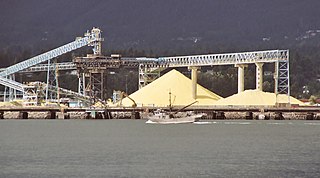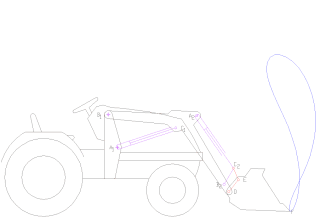
A conveyor belt is the carrying medium of a belt conveyor system. A belt conveyor system is one of many types of conveyor systems. A belt conveyor system consists of two or more pulleys, with a closed loop of carrying medium—the conveyor belt—that rotates about them. One or both of the pulleys are powered, moving the belt and the material on the belt forward. The powered pulley is called the drive pulley while the unpowered pulley is called the idler pulley. There are two main industrial classes of belt conveyors; Those in general material handling such as those moving boxes along inside a factory and bulk material handling such as those used to transport large volumes of resources and agricultural materials, such as grain, salt, coal, ore, sand, overburden and more.

A loader is a heavy equipment machine used in construction to move or load materials such as soil, rock, sand, demolition debris, etc. into or onto another type of machinery.

Heavy equipment or heavy machinery or Earthmover refers to heavy-duty vehicles specially designed to execute construction tasks, most frequently involving earthwork operations or other large construction tasks. Heavy equipment usually comprises five equipment systems: the implement, traction, structure, power train, and control/information.

A dump truck, known also as a dumping truck, dump trailer, dumper trailer, dump lorry or dumper lorry or a dumper for short, is used for transporting materials for construction as well as coal. A typical dump truck is equipped with an open-box bed, which is hinged at the rear and equipped with hydraulic rams to lift the front, allowing the material in the bed to be deposited ("dumped") on the ground behind the truck at the site of delivery. In the UK, Australia, South Africa and India the term applies to off-road construction plants only and the road vehicle is known as a tip lorry, tipper lorry, tipper truck, tip truck, tip trailer or tipper trailer or simply a tipper.

In civil engineering, a wheel tractor-scraper is a type of heavy equipment used for earthmoving. It has a pan/hopper for loading and carrying material. The pan has a tapered horizontal front cutting edge that cuts into the soil like a carpenter's plane or cheese slicer and fills the hopper which has a movable ejection system. The horsepower of the machine, depth of the cut, type of material, and slope of the cut area affect how quickly the pan is filled.

Mighty Machines is a Canadian educational children's television series that teaches about machines and how they work. The show premiered in 1994 airing 39 episodes over three seasons in 1994, 2004, and 2008.

A semi-trailer is a trailer without a front axle. In the United States, the term is also used to refer to the combination of a truck and a semi-trailer; a tractor-trailer.

The Euclid Company of Ohio was a company that specialized in heavy equipment for earthmoving, namely dump trucks, loaders and wheel tractor-scrapers. It operated in the US from the 1920s to the 1950s, when it was purchased by General Motors. It was later purchased by Hitachi Construction Machinery.

A moving floor is a hydraulically-driven moving-floor conveyance system for moving bulk material or palletized products, which can be used in a warehouse, loading dock or semi-trailer. It automates and facilitates loading and unloading of palletized goods by eliminating the need for a forklift to enter the trailer. In a truck-based application, the system can quickly unload loose material without having to tip the trailer or tilt the floor as with other dumping systems. In a bulk material application such as a waste facility, these systems can reduce double handling by allowing any vehicle to deliver material to the conveying floor and move heavy bulk materials to subsequent stages of a process. For bagged waste, the system can also be combined with bag openers.

An articulated hauler, articulated dump truck (ADT), or sometimes a dump hauler, is a very large heavy-duty type of dump truck used to transport loads over rough terrain, and occasionally on public roads. The vehicle usually has all-wheel drive and consists of two basic units: the front section, generally called the tractor, and the rear section that contains the dump body, called the hauler or trailer section. Steering is made by pivoting the front in relation to the back by hydraulic rams. This way, all wheels follow the same path, making it an excellent off-road vehicle.

A belt trailer or self unloading belt trailer is a semi-trailer that uses either a chain and flap assembly or a continuous belt that runs lengthwise on the bottom of the trailer. The belt is bolted to bars that in turn bolt to a chain that runs the length of the trailer. This belt is usually composed of rubber that allows the belt to grip the product and various widths are available depending on manufacturer generally ranging from 25 inches to 61 inches wide. A planetary, which is powered by a PTO pump, electric, or gas motor, cycles the belt.

A conveyor system is a common piece of mechanical handling equipment that moves materials from one location to another. Conveyors are especially useful in applications involving the transport of heavy or bulky materials. Conveyor systems allow quick and efficient transport for a wide variety of materials, which make them very popular in the material handling and packaging industries. They also have popular consumer applications, as they are often found in supermarkets and airports, constituting the final leg of item/ bag delivery to customers. Many kinds of conveying systems are available and are used according to the various needs of different industries. There are chain conveyors as well. Chain conveyors consist of enclosed tracks, I-Beam, towline, power & free, and hand pushed trolleys.
A specialized set of jargon describe the tools, equipment, and employment sectors used in the trucking industry in the United States. Some terms may be used within other English-speaking countries, or within the freight industry in general. For example, shore power is a term borrowed from shipping terminology, in which electrical power is transferred from shore to ship, instead of the ship relying upon idling its engines. Drawing power from land lines is more efficient than engine idling and eliminates localized air pollution. Another borrowed term is "landing gear", which refers to the legs which support the front end of a semi-trailer when it is not connected to a semi-truck. Some nicknames are obvious wordplay, such as "portable parking lot", in reference to a truck that carries automobiles.

Haul trucks are off-highway, rigid dump trucks specifically engineered for use in high-production mining and heavy-duty construction environments. Haul trucks are also used for transporting construction equipment from job site to job site. Some are multi-axle in order to support the equipment that is being hauled.

Open wagons form a large group of railway goods wagons designed primarily for the transportation of bulk goods that are not moisture-retentive and can usually be tipped, dumped or shovelled. The International Union of Railways (UIC) distinguishes between ordinary wagons and special wagons (F/6). Open wagons often form a significant part of a railway company's goods wagon fleet; for example, forming just under 40% of the Deutsche Bahn's total goods wagon stock in Germany.
Tyco US-1 Electric Trucking was a slot car line made by Tyco Slot Cars from 1981-1985. It’s theme was based around road and construction heavy-duty diesel trucks. It was marketed under the tagline of "You Control The Action!"

In North America, a roll-off is a usually open-top dumpster characterized by a rectangular footprint, utilizing wheels to facilitate rolling the dumpster in place. The container is designed to be transported by special roll-off trucks. There are two types of delivery trucks for the bins based on bin size, and they are: Hook lift bins and Roll-off bins. Roll-offs are commonly used to contain loads of construction and demolition waste or other waste types. While most roll-off containers have a swinging door on the end for easier disposal of waste, some roll-off containers are not open-top and are used with commercial or industrial trash compactors.

Telescopic cylinders are a special design of a hydraulic cylinder or pneumatic cylinder as well as pulley system which provide an exceptionally long output travel from a very compact retracted length. Typically the collapsed length of a telescopic cylinder is 20 to 40% of the fully extended length depending on the number of stages. Some pneumatic telescoping units are manufactured with retracted lengths of under 15% of overall extended unit length. This feature is very attractive to machine design engineers when a conventional single stage rod style actuator will not fit in an application to produce the required output stroke.

A logging truck or timber lorry is a large truck used to carry logs. Some have integrated flatbeds, some are discrete tractor units, and some are configured to spread a load between the tractor unit and a dollied trailer pulled behind it. Often more than one trailer is attached.

The Mack MC/MR series, also known as the "Cruise-Hauler", is a cabover truck first introduced in 1978. It is of a distinct "set back front axle" design, with the driver compartment mounted ahead of the front axle and with a large, flat, divided windscreen covering almost half of the truck's frontal aspect.



















